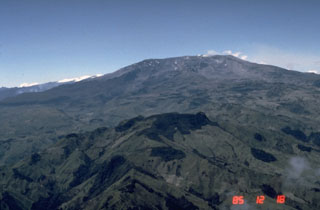Report on Nevado del Ruiz (Colombia) — 18 May-24 May 2016
Smithsonian Institution / US Geological Survey
Weekly Volcanic Activity Report, 18 May-24 May 2016
Managing Editor: Sally Sennert.
Please cite this report as:
Global Volcanism Program, 2016. Report on Nevado del Ruiz (Colombia) (Sennert, S, ed.). Weekly Volcanic Activity Report, 18 May-24 May 2016. Smithsonian Institution and US Geological Survey.
Nevado del Ruiz
Colombia
4.892°N, 75.324°W; summit elev. 5279 m
All times are local (unless otherwise noted)
Servicio Geológico Colombiano’s (SGC) Observatorio Vulcanológico y Sismológico de Manizales reported that during 17-23 May seismicity at Nevado del Ruiz was characterized by long-period and very-long-period earthquakes, episodes of continuous tremor, and pulses of volcanic tremor associated with gas-and-ash emissions. Significant amounts of water vapor and gas rose from the crater during the week. Ashfall was reported in La Florida, Manizales, on 20 May. According to a news article an ash emission on 22 May prompted closure of the La Nubia airport in Manizales. Later that day a gas, steam, and ash plume rose 2.5 km and drifted NW and W. Based on information from SGC, the Washington VAAC reported that on 17 May an ash emission rose to an altitude of 7 km (23,000 ft) a.s.l. Cloud cover in the area prevented satellite observations of the activity. The Alert Level remained at III (Yellow; the second lowest level on a four-color scale).
Geological Summary. Nevado del Ruiz is a broad, glacier-covered volcano in central Colombia that covers more than 200 km2. Three major edifices, composed of andesitic and dacitic lavas and andesitic pyroclastics, have been constructed since the beginning of the Pleistocene. The modern cone consists of a broad cluster of lava domes built within the caldera of an older edifice. The 1-km-wide, 240-m-deep Arenas crater occupies the summit. The prominent La Olleta pyroclastic cone located on the SW flank may also have been active in historical time. Steep headwalls of massive landslides cut the flanks. Melting of its summit icecap during historical eruptions, which date back to the 16th century, has resulted in devastating lahars, including one in 1985 that was South America's deadliest eruption.
Sources: Servicio Geológico Colombiano (SGC), Washington Volcanic Ash Advisory Center (VAAC), Salon

